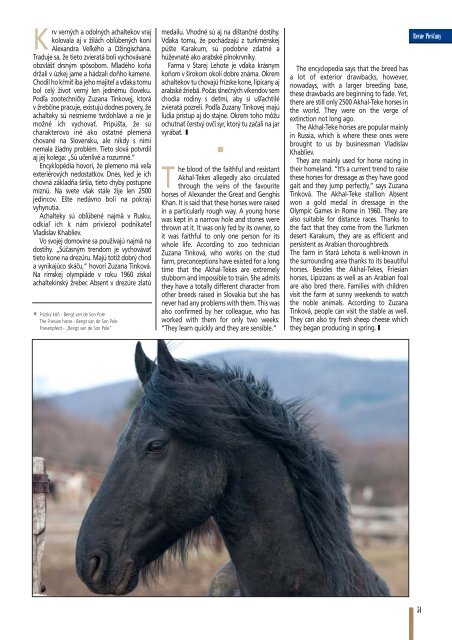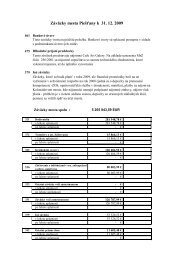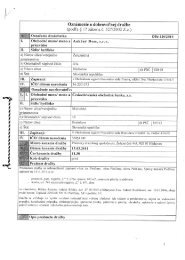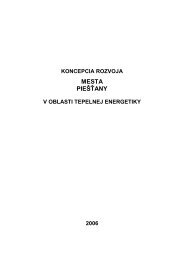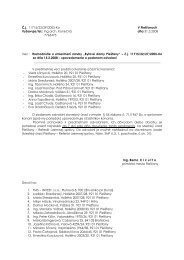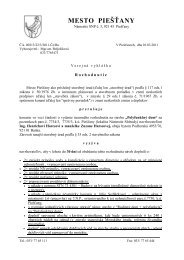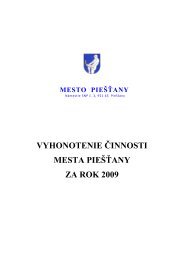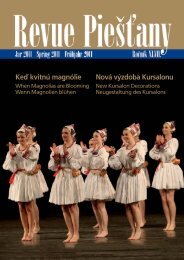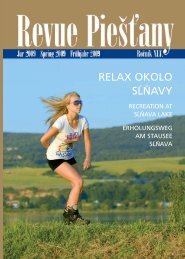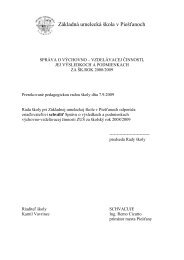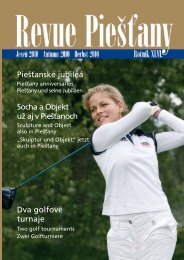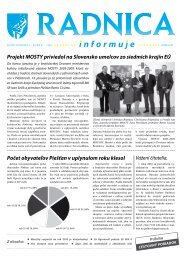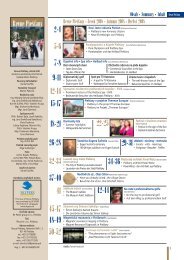Revue Piestany - leto 2010 - Piešťany
Revue Piestany - leto 2010 - Piešťany
Revue Piestany - leto 2010 - Piešťany
Sie wollen auch ein ePaper? Erhöhen Sie die Reichweite Ihrer Titel.
YUMPU macht aus Druck-PDFs automatisch weboptimierte ePaper, die Google liebt.
Krv verných a odolných achaltekov vraj<br />
kolovala aj v žilách obľúbených koní<br />
Alexandra Veľkého a Džingischána.<br />
Traduje sa, že tieto zvieratá boli vychovávané<br />
obzvlášť drsným spôsobom. Mladého koňa<br />
držali v úzkej jame a hádzali doňho kamene.<br />
Chodil ho kŕmiť iba jeho majiteľ a vďaka tomu<br />
bol celý život verný len jednému človeku.<br />
Podľa zootechničky Zuzana Tinkovej, ktorá<br />
v žrebčíne pracuje, existujú dodnes povery, že<br />
achalteky sú nesmierne tvrdohlavé a nie je<br />
možné ich vychovať. Pripúšťa, že sú<br />
charakterovo iné ako ostatné plemená<br />
chované na Slovensku, ale nikdy s nimi<br />
nemala žiadny problém. Tieto slová potvrdil<br />
aj jej kolega: „Sú učenlivé a rozumné.“<br />
Encyklopédia hovorí, že plemeno má veľa<br />
exteriérových nedostatkov. Dnes, keď je ich<br />
chovná základňa širšia, tieto chyby postupne<br />
miznú. Na svete však stále žije len 2500<br />
jedincov. Ešte nedávno boli na pokraji<br />
vyhynutia.<br />
Achalteky sú obľúbené najmä v Rusku,<br />
odkiaľ ich k nám priviezol podnikateľ<br />
Vladislav Khabliev.<br />
Vo svojej domovine sa používajú najmä na<br />
dostihy. „Súčasným trendom je vychovávať<br />
tieto kone na drezúru. Majú totiž dobrý chod<br />
a vynikajúco skáču,“ hovorí Zuzana Tinková.<br />
Na rímskej olympiáde v roku 1960 získal<br />
achaltekinský žrebec Absent v drezúre zlatú<br />
▼ Frízsky kôň - Bengt van de Son Pole<br />
The Friesian horse - Bengt van de Son Pole<br />
Friesenpferd - „Bengt van de Son Pole“<br />
medailu. Vhodné sú aj na dištančné dostihy.<br />
Vďaka tomu, že pochádzajú z turkménskej<br />
púšte Karakum, sú podobne zdatné a<br />
húževnaté ako arabské plnokrvníky.<br />
Farma v Starej Lehote je vďaka krásnym<br />
koňom v širokom okolí dobre známa. Okrem<br />
achaltekov tu chovajú frízske kone, lipicany aj<br />
arabské žriebä. Počas slnečných víkendov sem<br />
chodia rodiny s deťmi, aby si ušľachtilé<br />
zvieratá pozreli. Podľa Zuzany Tinkovej majú<br />
ľudia prístup aj do stajne. Okrem toho môžu<br />
ochutnať čerstvý ovčí syr, ktorý tu začali na jar<br />
vyrábať.. ❚<br />
■<br />
T<br />
he blood of the faithful and resistant<br />
Akhal-Tekes allegedly also circulated<br />
through the veins of the favourite<br />
horses of Alexander the Great and Genghis<br />
Khan. It is said that these horses were raised<br />
in a particularly rough way. A young horse<br />
was kept in a narrow hole and stones were<br />
thrown at it. It was only fed by its owner, so<br />
it was faithful to only one person for its<br />
whole life. According to zoo technician<br />
Zuzana Tinková, who works on the stud<br />
farm, preconceptions have existed for a long<br />
time that the Akhal-Tekes are extremely<br />
stubborn and impossible to train. She admits<br />
they have a totally different character from<br />
other breeds raised in Slovakia but she has<br />
never had any problems with them. This was<br />
also confirmed by her colleague, who has<br />
worked with them for only two weeks:<br />
“They learn quickly and they are sensible.”<br />
The encyclopedia says that the breed has<br />
a lot of exterior drawbacks, however,<br />
nowadays, with a larger breeding base,<br />
these drawbacks are beginning to fade. Yet,<br />
there are still only 2500 Akhal-Teke horses in<br />
the world. They were on the verge of<br />
extinction not long ago.<br />
The Akhal-Teke horses are popular mainly<br />
in Russia, which is where these ones were<br />
brought to us by businessman Vladislav<br />
Khabliev.<br />
They are mainly used for horse racing in<br />
their homeland. “It’s a current trend to raise<br />
these horses for dressage as they have good<br />
gait and they jump perfectly,” says Zuzana<br />
Tinková. The Akhal-Teke stallion Absent<br />
won a gold medal in dressage in the<br />
Olympic Games in Rome in 1960. They are<br />
also suitable for distance races. Thanks to<br />
the fact that they come from the Turkmen<br />
desert Karakum, they are as efficient and<br />
persistent as Arabian thoroughbreds.<br />
The farm in Stará Lehota is well-known in<br />
the surrounding area thanks to its beautiful<br />
horses. Besides the Akhal-Tekes, Friesian<br />
horses, Lipizzans as well as an Arabian foal<br />
are also bred there. Families with children<br />
visit the farm at sunny weekends to watch<br />
the noble animals. According to Zuzana<br />
Tinková, people can visit the stable as well.<br />
They can also try fresh sheep cheese which<br />
they began producing in spring. ❚<br />
51


